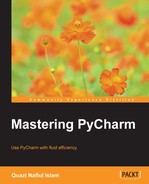TLDR: So you want more PyCharm productivity, but don't want to read a book. I get that! So, just head over to the main menu, go over to Help and then Productivity Guide. If you want to get down to the best tools, read Chapter 4, Editing, Chapter 5, Interpreters and Consoles, and Chapter 6, Debugging. However, if you read this book, you'll get a lot more.
Welcome to Mastering PyCharm. If you've bought this book, then you probably want to become more effective with PyCharm in your day-to-day work. However, whether you can truly master a tool as multifaceted as PyCharm is completely up for debate since PyCharm changes so fast and so quickly. However, what I can promise you is that you will learn a great deal not only about how to use PyCharm, but how PyCharm works as part of the IntelliJ ecosystem of IDEs and what that means in terms of tooling and extensibility.
Chapter 1, Getting the Right Look, will help you make PyCharm look the exact way you want it to. So, whether you want too many buttons or too few or you want to change the theme or modify it more effectively, PyCharm will help you do all these.
Chapter 2, Understanding the Keymap, will help you map all the actions to their shortcuts and search for the actions using the action name or by invoking the shortcut. If that doesn't make sense, it means you've been missing out on something. This chapter also covers how to overcome known problems with keyboard shortcuts.
Chapter 3, Getting Places, covers a host of tools that PyCharm has. These tools will help you navigate everything from a really large file to huge codebases with loads of packages.
Chapter 4, Editing, will explain all the tools and help you learn more about writing error-free code quickly.
Chapter 5, Interpreters and Consoles, covers a lot of interpreters that Python has. PyCharm can support a whole host of them and provide code completion inside the console and much more. If you don't read this chapter, you're really going to miss out on some of the most powerful tools PyCharm has to offer.
Chapter 6, Debugging, being an iterative chapter, covers how to incorporate PyCharm's powerful debugger in to your debugging workflow. Buckle up; this one's going to get greasy.
Chapter 7, The PyCharm Ecosystem, answers PyCharm's existential questions. Who makes it? How does it work? How do you extend it? Where do plugins come from? Oh, and a lot more.
Chapter 8, File Templates and Snippets, covers the powerful set of snippets and file templates that PyCharm has. This will help you pump out code as fast as you can hit Tab. This chapter also talks about how to make your own file templates and snippets and extend the ones that already exist, using the velocity templating language. After all, don't you hate writing the same stuff all over again, such as getters and setters or function declarations?
Chapter 9, Version Control Integration, is a short chapter on some of the good parts of PyCharm's version control features that support multiple version control systems.
Chapter 10, HTML and JavaScript Tools, covers a set of tools that PyCharm comes with, which will help you work with JavaScript efficiently. JavaScript is (unfortunately) everywhere!
Chapter 11, Web Development with PyCharm, talks about picking a web framework, any framework. Chances are that PyCharm supports it as well as the tools that support those frameworks such as SQLAlchemy and templating languages such as Jinja2 and Mako.
